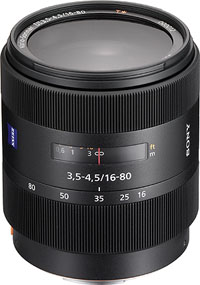Sony Alpha 100 June 2006 launch report
DRO and DRO+
If this was the end of the story, the Alpha 100 would already be an ‘add to my shopping basket’ item for many 7D or 5D owners. But the Alpha has something even more valuable in store, called DRO (marked D-R on the camera’s function dial).
DRO ‘Standard’ uses the 40 metering cells to asses the contrast of the scene, and then selects from a range of 400,000 possible gamma curves to adjust shadows, highlights, midtones, black and white points. This process takes only 0.04 seconds and the camera is effectively as fast using DRO as without.
DRO+ is an entirely different process, provided by London software company Apical Ltd. I found it so interesting I visited Apical and talked to Dr Michael Tusch, their CEO.

Limited by non-disclosure agreements, we were able at least to confirm that DRO+ is unique to Sony though Apical Ltd has provided Nikon with a similar process called D-Lighting for certain consumer range compacts, and Olympus licences part of their raw conversion software from this R&D based imaging company.
The DRO+ software is resident in the Sony BIONZ processor, and Mike Tusch was full of praise for the power and speed of this processor. He said it was unlikely a similar function would appear in other DSLRs for some time, and that Sony had really achieved a feat by making it possible on a 10.2 megapixel image (the Apical information says the maximum limit would be a 16 megapixel image).
It takes half a second for the camera to analyse the captured image, comparing differences between pixels and their near and distant neighbours. From this, a map of areas of light and dark detail is created and the software applies local gamma curve changes without ever creating a hard boundary. It is as if the contrast and brightness are judged by a human eye, which automatically compensates and sees into shadows, without bright areas becoming glaring in the process.
DRO+ processes the raw data, not the image stored on the memory card, but it’s been very hard to get a consistent answer as to whether this happens between the CCD and the buffer or between the buffer and the card. This is probably the secret element. From what I have learned about the .ARW raw file format, it is more likely that the processing happens early on. The .ARW format divides the image into neat blocks of R, G and B data which don’t read out in a literal Bayer pattern order. This enables Sony to compress the data losslessly with maximum speed and effectiveness. The raw format is particularly fast to read for review on the large 2.5 inch rear screen which is as bright as the 5D and finer in detail than the 7D. The image appears almost instantly because of the way the blocks of data can be sampled.
The very powerful BIONZ processor is doing far more than many DSLR imaging engines. It will, for example, create High quality JPEGs from captures at a rate of 3 frames per second for an unlimited period – up to the capacity of the card (either CompactFlash, or the very affordable and fast MemoryStick DUO PRO used in a CompactFlash adaptor provided with the camera).
We will be looking in detail at Dynamic Range Optimisation and trying to find out more about the process. Sony state that it does not work on raw .ARW capture or RAW+JPEG, but in ignorance of this, I tested it in three modes (Off, Standard and Enhanced – Off, D-R and D-R+) without disabling raw shooting. Since there appeared to be significant shadow detail improvement in the raw shots and JPEGs alike, I assumed it was active. Mike Tusch told me it could optimise a raw file, and did not have to be just a JPEG, but that was entirely up to Sony’s implementation.
DRO+ promises some worthwhile enhancements to pictures which would be very poor without it. Excess contrast between lit and unlit areas, strong backlight and problems with white dresses and dark suits are all automatically tackled by DRO+.
The half-second process time does not slow the camera down, either; it just delays the overall start and end of writing a sequence of shots. The first shot won’t hit the memory card until half a second late, but the next shot follows just as fast as if DRO+ had been turned off.
This may explain why the Alpha 100 appears to have a smaller buffer memory than the Dynax 7D, and will only guarantee a series of three consecutive RAW+JPEG frames at 3 fps (slightly faster than the 7D’s 2.8 fps). I suspect the buffer memory has been partitioned, a kind of dual buffer, to allow for the intensive image processing and sequence writing.
Lens compatibility
But, to conclude this first report on the Alpha system, it’s important to cover all the questions which many internet correspondents have raised with me (and others).
First of all, the new Sony range of ‘normal’ lenses is nothing less than the original Minolta lens range – 16mm f/2.8, 20mm f/2.8, 28mm f/2.8, 50mm f/2.8 Macro, 100mm f/2.8 Macro, 50mm f/1.4, 500mm f/8 reflex, 135mmf/2.8 (T4.5) STF, 24-105mm, and 75-300mm all are full frame and fully compatible with M-AF (Alpha mount) SLRs back to 1985.
The top-drawer 35mm f/1.4 G (D) is equally compatible, but the 70-200mm f/2.8 SSM, 300mm f/2.8 SSM and apo tele-converters are only compatible with those Minolta and Konica Minolta models which were SSM capable.
The 11-18mm, 18-70mm and 18-200mm lenses are digital APS format only but again fully backward compatible with the Dynax 7D and 5D.

We do not have full details of the compatibility of the new Carl Zeiss lenses for Alpha – a Minolta-G-replacing 85mm f/1.4 Planar T* ZA; a full frame 24-70mm f/2.8 Vario-Sonnar T* ZA; an unexpected 135mm f/1.8 Sonnar T* ZA full frame; and a digital-only 16-80mm f/3.5-4.5 Vario-Sonnar DT ZA. Their backwards compatibility will depend on the type of focusing mechanism used, yet to be revealed.
Based on brief use of the 18-70mm and 75-300mm in Morocco, I can confirm that both these lenses appear to have been improved and it’s not mere cosmetics. The whole Alpha 100 focusing experience is faster and more positive and these lenses were already excellent designs optically. The barrels and zoom action have been firmed up a touch and the focusing resistance better matched to the camera.
As for future lens releases, we don’t know what they are but the gaps in the launch range for 2006 may indicate what to expect in 2007.
